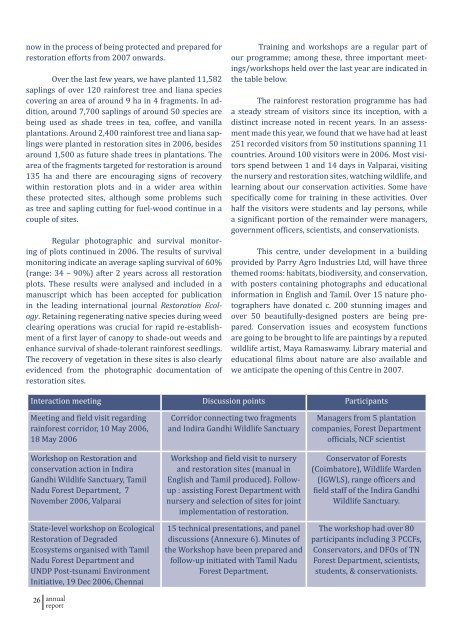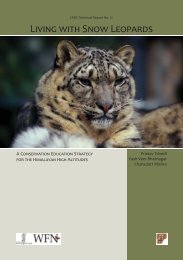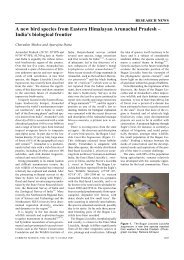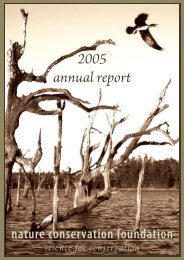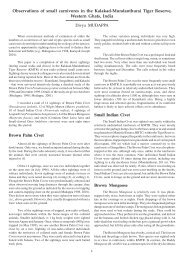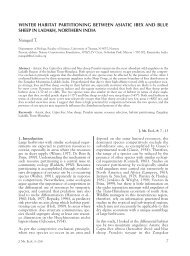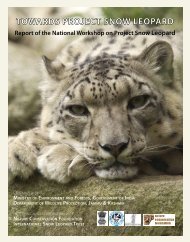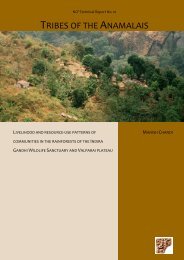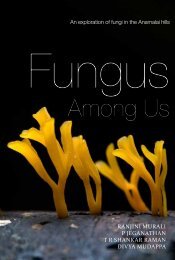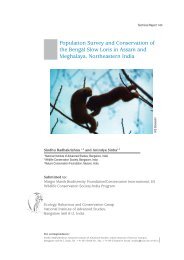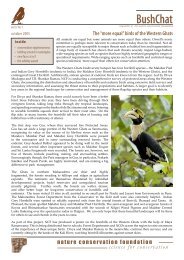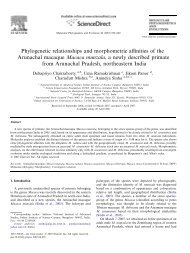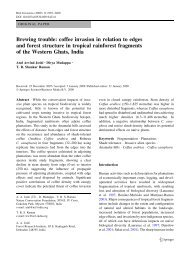2006-7 annual report - Nature Conservation Foundation
2006-7 annual report - Nature Conservation Foundation
2006-7 annual report - Nature Conservation Foundation
Create successful ePaper yourself
Turn your PDF publications into a flip-book with our unique Google optimized e-Paper software.
now in the process of being protected and prepared for<br />
restoration efforts from 2007 onwards.<br />
Over the last few years, we have planted 11,582<br />
saplings of over 120 rainforest tree and liana species<br />
covering an area of around 9 ha in 4 fragments. In addition,<br />
around 7,700 saplings of around 50 species are<br />
being used as shade trees in tea, coffee, and vanilla<br />
plantations. Around 2,400 rainforest tree and liana saplings<br />
were planted in restoration sites in <strong>2006</strong>, besides<br />
around 1,500 as future shade trees in plantations. The<br />
area of the fragments targeted for restoration is around<br />
135 ha and there are encouraging signs of recovery<br />
within restoration plots and in a wider area within<br />
these protected sites, although some problems such<br />
as tree and sapling cutting for fuel-wood continue in a<br />
couple of sites.<br />
Regular photographic and survival monitoring<br />
of plots continued in <strong>2006</strong>. The results of survival<br />
monitoring indicate an average sapling survival of 60%<br />
(range: 34 – 90%) after 2 years across all restoration<br />
plots. These results were analysed and included in a<br />
manuscript which has been accepted for publication<br />
in the leading international journal Restoration Ecology.<br />
Retaining regenerating native species during weed<br />
clearing operations was crucial for rapid re-establishment<br />
of a first layer of canopy to shade-out weeds and<br />
enhance survival of shade-tolerant rainforest seedlings.<br />
The recovery of vegetation in these sites is also clearly<br />
evidenced from the photographic documentation of<br />
restoration sites.<br />
Training and workshops are a regular part of<br />
our programme; among these, three important meetings/workshops<br />
held over the last year are indicated in<br />
the table below.<br />
The rainforest restoration programme has had<br />
a steady stream of visitors since its inception, with a<br />
distinct increase noted in recent years. In an assessment<br />
made this year, we found that we have had at least<br />
251 recorded visitors from 50 institutions spanning 11<br />
countries. Around 100 visitors were in <strong>2006</strong>. Most visitors<br />
spend between 1 and 14 days in Valparai, visiting<br />
the nursery and restoration sites, watching wildlife, and<br />
learning about our conservation activities. Some have<br />
specifically come for training in these activities. Over<br />
half the visitors were students and lay persons, while<br />
a significant portion of the remainder were managers,<br />
government officers, scientists, and conservationists.<br />
This centre, under development in a building<br />
provided by Parry Agro Industries Ltd, will have three<br />
themed rooms: habitats, biodiversity, and conservation,<br />
with posters containing photographs and educational<br />
information in English and Tamil. Over 15 nature photographers<br />
have donated c. 200 stunning images and<br />
over 50 beautifully-designed posters are being prepared.<br />
<strong>Conservation</strong> issues and ecosystem functions<br />
are going to be brought to life are paintings by a reputed<br />
wildlife artist, Maya Ramaswamy. Library material and<br />
educational films about nature are also available and<br />
we anticipate the opening of this Centre in 2007.<br />
Interaction meeting Discussion points Participants<br />
Meeting and field visit regarding<br />
rainforest corridor, 10 May <strong>2006</strong>,<br />
18 May <strong>2006</strong><br />
Workshop on Restoration and<br />
conservation action in Indira<br />
Gandhi Wildlife Sanctuary, Tamil<br />
Nadu Forest Department, 7<br />
November <strong>2006</strong>, Valparai<br />
State-level workshop on Ecological<br />
Restoration of Degraded<br />
Ecosystems organised with Tamil<br />
Nadu Forest Department and<br />
UNDP Post-tsunami Environment<br />
Initiative, 19 Dec <strong>2006</strong>, Chennai<br />
Corridor connecting two fragments<br />
and Indira Gandhi Wildlife Sanctuary<br />
Workshop and field visit to nursery<br />
and restoration sites (manual in<br />
English and Tamil produced). Followup<br />
: assisting Forest Department with<br />
nursery and selection of sites for joint<br />
implementation of restoration.<br />
15 technical presentations, and panel<br />
discussions (Annexure 6). Minutes of<br />
the Workshop have been prepared and<br />
follow-up initiated with Tamil Nadu<br />
Forest Department.<br />
Managers from 5 plantation<br />
companies, Forest Department<br />
officials, NCF scientist<br />
Conservator of Forests<br />
(Coimbatore), Wildlife Warden<br />
(IGWLS), range officers and<br />
field staff of the Indira Gandhi<br />
Wildlife Sanctuary.<br />
The workshop had over 80<br />
participants including 3 PCCFs,<br />
Conservators, and DFOs of TN<br />
Forest Department, scientists,<br />
students, & conservationists.<br />
26<br />
<strong>annual</strong><br />
<strong>report</strong>


